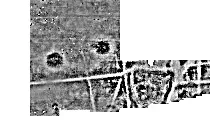Resistivity survey measures the electrical resistance of the earth’s soil moisture content. A twin probe configuration is normally carried out, which involves the pairing of electrodes (one current and one potential), with one pair remaining in a fixed position (remote probes), whilst the mobile probes measure variations in electrical resistance across the survey grids. Resistance is measured in ohms, and this method generally detects to a depth of 1m.
Features such as wall foundations are usually identified as high resistance anomalies, as well as rubble spreads, made surfaces (i.e. yards and paths) and metalled roads and trackways.
In contrast, low resistance values are normally associated with water-retentive features such as large pits, ditches, drains and gullies. This technique is usually recommended for prospection of known or suspected structural remains.

Medieval Monastic Grange
and Bronze Age Barrows

